The Quest of Tea in Taipei<br>A Journey through the Joys of Maokong's Tieguanyin Tea
The museum also hosts special“Tiger Nose Master” tasting activities to educate members of the public about the character and nuances of Maokong tea leaf. The emphasis is on fun: Zhang says that five types of tea are made and used to fill ten cups that are placed before a visitor. The taste-tester then has to match the two cups of each variety. The task is in fact not so very difficult, for each tea of different maturity, from raw to fully ripened, has a noticeably different color, and the character variation becomes even more evident once nose and taste bud are brought into play. Experts are also on hand to give explanation, making these pleasant gatherings quite popular. As a result, registration is required three days in advance. In February this year (2009), the city government completed the wonderful new Zhangshu (Camphor Tree) Trail, which starts before the museum and stretchesfrom the Maokong Gondola Station to Zhangshan (Camphor Tree Mountain) Temple , allowing visitors to saunter freely through the pastoral beauties of the plantations and immerse yourself in an idyllic view. This cozy facility honors a man who gave much of his life to fostering the cultivation of quality Tieguanyin Tea in the Muzha community. Both plant and technique for Tieguanyin and the area's other star, Wenshan Baozhong Tea , were transplanted across the Taiwan Strait from mainland China during Taiwan's pioneer days. Zhang, who had studied the art since childhood, brought Tieguanyin plants over from Fujian Province in 1895, replanting them at Muzha's Camphor-Tree Lake Mountain. During the Japanese colonial period (1895-1945) Zhang entered The multi-talented Zhang has also spent many years studying the art of paper-carving, and the numerous original works on hand provide you insight into another world of horizons. Finally, there is a fine collection of mementoes and keepsakes to wade through, including bookmarkers depicting the history of tea by Beijing painting talent, books on tea history, small ceramic works, and much more - all fine additions to your own home collection, perhaps started with these very purchases.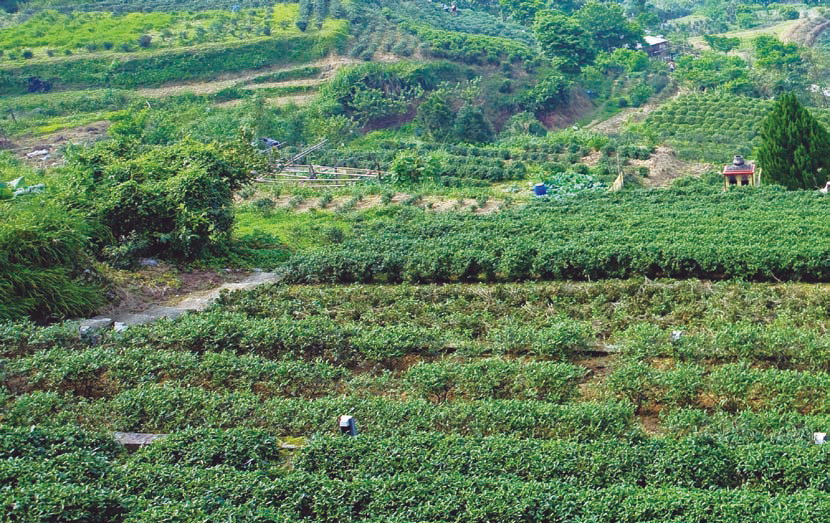 An outing for a spot of tea on the verdant slopes of the Maokong area in southeast Taipei has become a favorite excursion for local folk. The term“Maokong”means“cat's hollows;”nothing at all to do with tea, but an unusual name of savory interest. The Maokong area is formed by a stream running between two high hills in the low mountains of the Muzha tea-plantation district. Over the eons, the waters have chiselled kettle holes in the boulders and stones along the stream bed, which long ago struck pioneer settlers as looking like marks left behind by cats' paws as they sauntered along.“Mao” means“cat,”and“kong” means“hollow.”The picturesque name stuck and eventually became official. You can explore the peculiar landscape yourself by taking the signposted trail directly in front of the Taipei Tea Promotion Center for Tieguanyin Tea and Baozhong Tea.
An outing for a spot of tea on the verdant slopes of the Maokong area in southeast Taipei has become a favorite excursion for local folk. The term“Maokong”means“cat's hollows;”nothing at all to do with tea, but an unusual name of savory interest. The Maokong area is formed by a stream running between two high hills in the low mountains of the Muzha tea-plantation district. Over the eons, the waters have chiselled kettle holes in the boulders and stones along the stream bed, which long ago struck pioneer settlers as looking like marks left behind by cats' paws as they sauntered along.“Mao” means“cat,”and“kong” means“hollow.”The picturesque name stuck and eventually became official. You can explore the peculiar landscape yourself by taking the signposted trail directly in front of the Taipei Tea Promotion Center for Tieguanyin Tea and Baozhong Tea.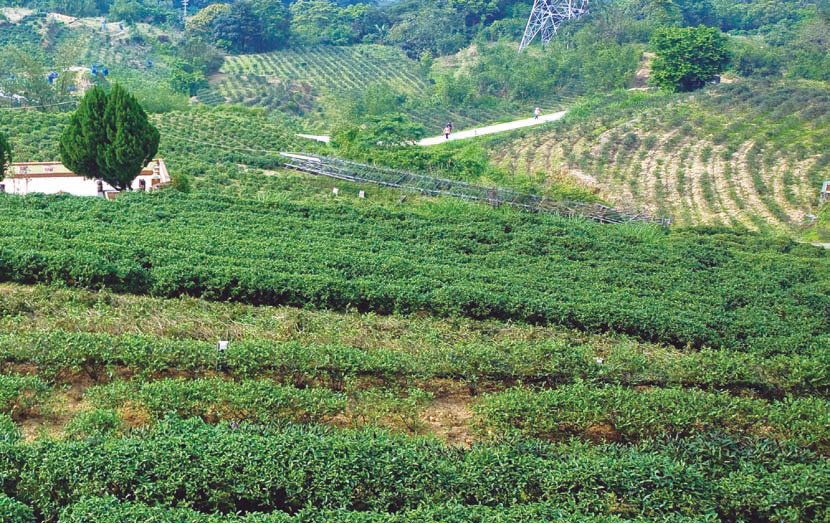 Tieguanyin Tea(Iron Goddess Tea ) was brought to the Maokong area by the tea-master Zhang Nai-miao , who passed on the secrets of the strain and the art of its cultivation to local folk. After 1960, the government of Taiwan launched energetic efforts to promote tea-plantation tourism in Muzha, bringing Maokong island-wide renown as a tea-growing rural idyll. Beyond meandering through the aromatic plantations and sitting down for a leisurely pot of fine brew complemented by fine views, there are also a number of special tea-education facilities that simmer with intellectual and hands-on sensory stimulation. These include Threestone Teapot Museum , dedicated to the famed Yixing Zisha teapots of China, and Zhang Nai-miao Memorial Hall , which introduces tea's history and tea culture.
Tieguanyin Tea(Iron Goddess Tea ) was brought to the Maokong area by the tea-master Zhang Nai-miao , who passed on the secrets of the strain and the art of its cultivation to local folk. After 1960, the government of Taiwan launched energetic efforts to promote tea-plantation tourism in Muzha, bringing Maokong island-wide renown as a tea-growing rural idyll. Beyond meandering through the aromatic plantations and sitting down for a leisurely pot of fine brew complemented by fine views, there are also a number of special tea-education facilities that simmer with intellectual and hands-on sensory stimulation. These include Threestone Teapot Museum , dedicated to the famed Yixing Zisha teapots of China, and Zhang Nai-miao Memorial Hall , which introduces tea's history and tea culture. Muzha Tourist Tea Plantations
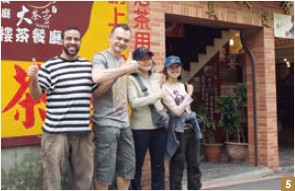 The Muzha Tourist Tea Plantations is along Sec. 3 of Zhinan Rd. in the city's Wenshan District. The enterprises now cover over 100 hectares, and yearly production surpasses 30,000 kilograms of leaf. This is Taiwan's prime source of Tieguanyin Tea, and was also the city's first designated area for agricultural tourism. There are now 90 tourist plantations in operation, most dedicated to the cultivation of Tieguanyin Tea.
The Muzha Tourist Tea Plantations is along Sec. 3 of Zhinan Rd. in the city's Wenshan District. The enterprises now cover over 100 hectares, and yearly production surpasses 30,000 kilograms of leaf. This is Taiwan's prime source of Tieguanyin Tea, and was also the city's first designated area for agricultural tourism. There are now 90 tourist plantations in operation, most dedicated to the cultivation of Tieguanyin Tea. Tieguanyin leaf at the Muzha plantations is half-fermented, with the spring and winter harvests highest in quality. As you move up into the hills along Zhinan Rd. from Chengchi University, you are regaled with row upon neat row of tea bushes along the road's sections 2 and 3, stretching right from the crest down to mid-slope on the mountainside. Each dedicated plantation teahouse, whether courtyard or open-air style, has its own unique personality. Along the uphill journey, you'll enjoy a feast of the senses, greens tickling the eye and fragrances of leaf and blossom teasing the nose. The palate sensations begin once you have made your teahouse determination. It's an abrupt change from the big-city noise you've left mere minutes ago, and as a sense of peace and serenity wrap you up as though in a warm blanket, you might well think this is the feeling a traveler might experience upon stumbling into Shangri-La.
Tieguanyin leaf at the Muzha plantations is half-fermented, with the spring and winter harvests highest in quality. As you move up into the hills along Zhinan Rd. from Chengchi University, you are regaled with row upon neat row of tea bushes along the road's sections 2 and 3, stretching right from the crest down to mid-slope on the mountainside. Each dedicated plantation teahouse, whether courtyard or open-air style, has its own unique personality. Along the uphill journey, you'll enjoy a feast of the senses, greens tickling the eye and fragrances of leaf and blossom teasing the nose. The palate sensations begin once you have made your teahouse determination. It's an abrupt change from the big-city noise you've left mere minutes ago, and as a sense of peace and serenity wrap you up as though in a warm blanket, you might well think this is the feeling a traveler might experience upon stumbling into Shangri-La.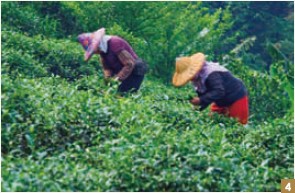 The area is open year-round, with no such thing as a general admission—you're free to roam about. Each teahouse will of course charge for food and drink, however. Most of the teahouses open around noon each day and go into the wee hours. If you'd like a tour, booking ahead is advised. At these establishments, you can buy packaged teas from the respective plantation, sit down for some fresh-brew tea, and enjoy the area's prized tea cuisine. Most of the tea-cuisine foods, notably the popular range chicken, come from the plantation itself or nearby growers. The area is a huge draw for families and friends to sit down for hearty food and delicate drink while enjoying the pristine views. Especially at night, when the breezes float up, and the city beyond turns into a sparkling crystal.
The area is open year-round, with no such thing as a general admission—you're free to roam about. Each teahouse will of course charge for food and drink, however. Most of the teahouses open around noon each day and go into the wee hours. If you'd like a tour, booking ahead is advised. At these establishments, you can buy packaged teas from the respective plantation, sit down for some fresh-brew tea, and enjoy the area's prized tea cuisine. Most of the tea-cuisine foods, notably the popular range chicken, come from the plantation itself or nearby growers. The area is a huge draw for families and friends to sit down for hearty food and delicate drink while enjoying the pristine views. Especially at night, when the breezes float up, and the city beyond turns into a sparkling crystal.Threestone Teapot Museum
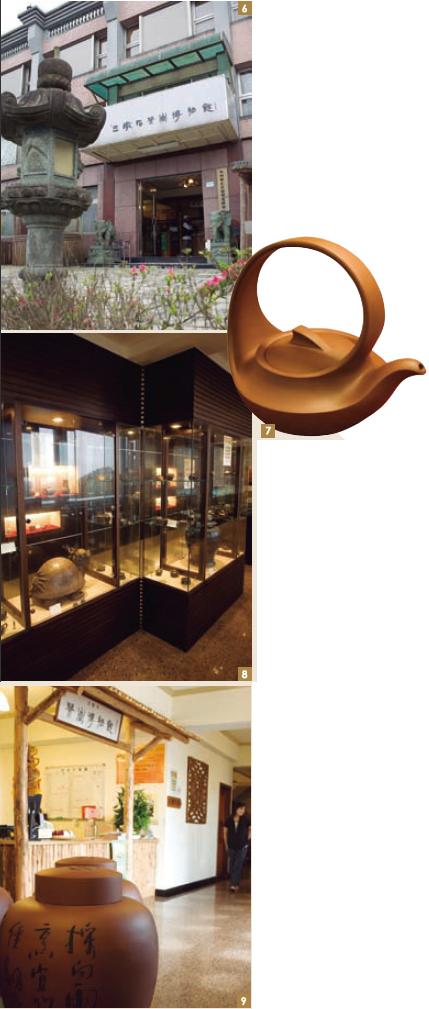
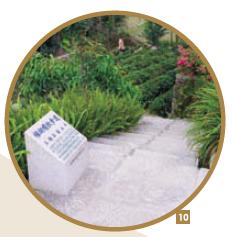 The curator of the Threestone Teapot Museum, an attractive three-story facility located on Zhinan Rd., is Zhang Kun-hong , from the ninth generation of a clan of local tea cultivators. The family's plantation, in fact, is right across the road. There's nothing that Zhang loves better than doing some picking himself during the winter and spring harvests. He has long had a love for the pick of the crop in the Chinese world of teapots, Yixing Zisha teapots, and has been diligently collecting the best over the past 30-plus years. Zhang has now made his large teapot trove available for public appreciation and edification at Threestone, which is the former family-plantation teahouse overhauled and given new duty. Yixing teapots are made from Zisha (purple clay) found only around Yixing in China's Jiangsu province; it is believed this clay is best at bringing out the best in tea leaves, the pots becoming even better with maturity. The collection is large, at over 1,000 teapots, about 400 of these zisha treasures, and so selected groupings are displayed in irregular rotation. There are also regular and specialty exhibits on teapot art.
The curator of the Threestone Teapot Museum, an attractive three-story facility located on Zhinan Rd., is Zhang Kun-hong , from the ninth generation of a clan of local tea cultivators. The family's plantation, in fact, is right across the road. There's nothing that Zhang loves better than doing some picking himself during the winter and spring harvests. He has long had a love for the pick of the crop in the Chinese world of teapots, Yixing Zisha teapots, and has been diligently collecting the best over the past 30-plus years. Zhang has now made his large teapot trove available for public appreciation and edification at Threestone, which is the former family-plantation teahouse overhauled and given new duty. Yixing teapots are made from Zisha (purple clay) found only around Yixing in China's Jiangsu province; it is believed this clay is best at bringing out the best in tea leaves, the pots becoming even better with maturity. The collection is large, at over 1,000 teapots, about 400 of these zisha treasures, and so selected groupings are displayed in irregular rotation. There are also regular and specialty exhibits on teapot art.Zhang Nai-miao Memorial Hall
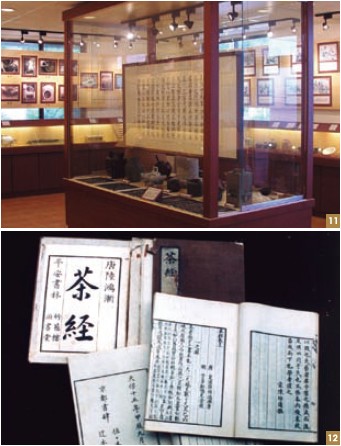 the imperial competition for Baozhong Tea, taking the Taiwan governor-general's gold prize. The youngest tea master to ever win such an honor, he was appointed inspector-general for tea in Taipei prefecture and thereafter benefited the entire region by passing on his deeply cultivated warehouse of knowledge in the tea-making arts. (Note: Baozhong Tea does not indicate a different leaf variety; it is leaf processed with minimum rolling/drying and a resulting larger leaf that having undergone only slight oxidation).
the imperial competition for Baozhong Tea, taking the Taiwan governor-general's gold prize. The youngest tea master to ever win such an honor, he was appointed inspector-general for tea in Taipei prefecture and thereafter benefited the entire region by passing on his deeply cultivated warehouse of knowledge in the tea-making arts. (Note: Baozhong Tea does not indicate a different leaf variety; it is leaf processed with minimum rolling/drying and a resulting larger leaf that having undergone only slight oxidation).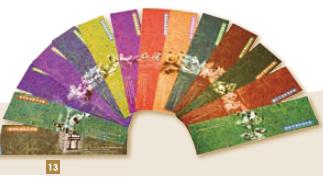 The memorial hall is run by Zhang Wei-yi , a furniture designer by training, representing the third generation of the family. Decades of research and collecting have gone into the displays you will be enjoying, journeying through the life, relics, and concepts of the patriarchal tea master. Models of the various types of machinery and instruments are also on display, along with photographs, which are used to explain the different production processes for the many types of teas. The hall's mission is to both preserve and help the timeless tea culture to flourish, says Zhang, and the hall itself is partitioned thus: the first floor has poetry on the glories of tea and educational materials on its historical development; the second floor has major displays divided in accordance with six major themes, with guides on hand with explanation in English and Chinese.
The memorial hall is run by Zhang Wei-yi , a furniture designer by training, representing the third generation of the family. Decades of research and collecting have gone into the displays you will be enjoying, journeying through the life, relics, and concepts of the patriarchal tea master. Models of the various types of machinery and instruments are also on display, along with photographs, which are used to explain the different production processes for the many types of teas. The hall's mission is to both preserve and help the timeless tea culture to flourish, says Zhang, and the hall itself is partitioned thus: the first floor has poetry on the glories of tea and educational materials on its historical development; the second floor has major displays divided in accordance with six major themes, with guides on hand with explanation in English and Chinese.
Information Muzha Tourist Tea Plantation Community Development Association (provides information on each tea plantation)
Tel: (02) 2938-3797
Add: 36, Lane 34, Sec. 3, Zhinan Rd.
Hours: Open year-round
Threestone Teapot Museum
Tel: (02) 2938-3797
Add: 36, Lane 34, Sec. 3, Zhinan Rd.
Hours: Tues - Sun 10:00 - 18:00
Admission: NT$80
Zhang Nai-miao Memorial Hall
Tel: (02) 2938-2579
Add: 53-2, Lane 34, Sec. 3, Zhinan Rd.
Hours: Mon - Sat 08:00 - 16:00 (closed Sun)
Admission: NT$150 (includes guided tour and tea tastetesting)

![Taiwan.gov.tw [ open a new window]](/images/egov.png)
